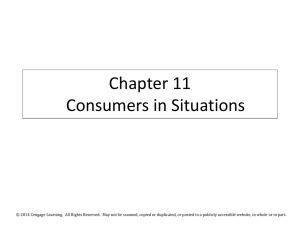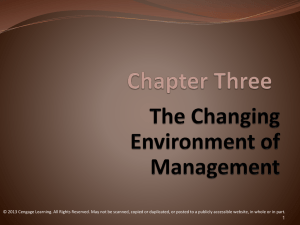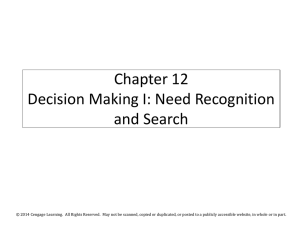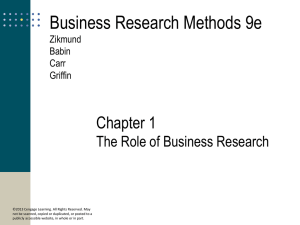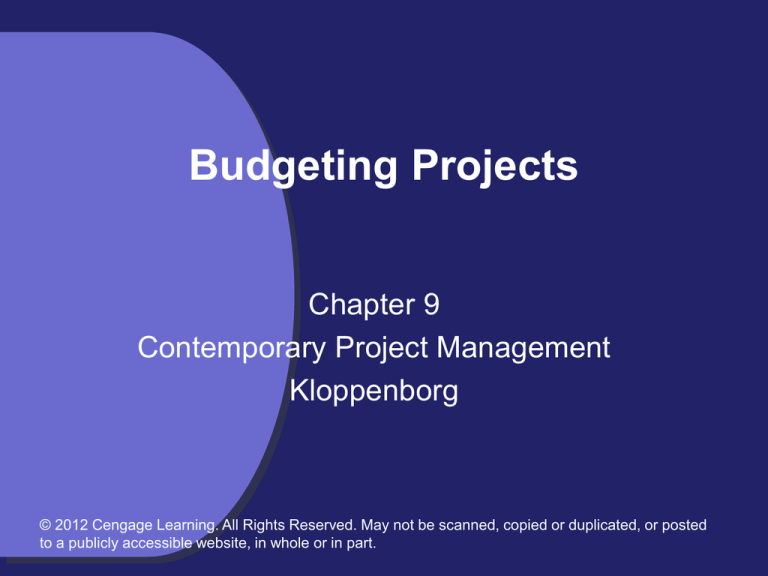
Budgeting Projects
Chapter 9
Contemporary Project Management
Kloppenborg
© 2012 Cengage Learning. All Rights Reserved. May not be scanned, copied or duplicated, or posted
to a publicly accessible website, in whole or in part.
Chapter
Vignette
Elevator Sales
• Denver fast method bidding
– Gather RFPs, plans, specifications
– Put together an estimate
– Conduct actual bidding
• Kansas City
– Time to develop detailed cost estimates
• There are many methods of estimating project
costs
© 2012 Cengage Learning. All Rights Reserved. May not be scanned, copied or duplicated, or posted
to a publicly accessible website, in whole or in part.
At the end of this chapter…
• Define project cost terms and tell how each is
used in estimating project cost.
• Compare and contrast analogous, parametric,
and bottom-up methods of estimating cost.
• Describe issues in project cost estimating and
how to deal with each.
• Create a time-phase bottom-up budget for a
project.
• Show summary and bottom-up project budget
information with cumulative costs using MS
Project.
© 2012 Cengage Learning. All Rights Reserved. May not be scanned, copied or duplicated, or posted
to a publicly accessible website, in whole or in part.
Introduction to Project Budgeting
• Involves developing a cost management plan for
a project
• For small projects
– Ensure accurate cost estimates
– Secure the funding
– Develop cost reporting procedures
• For large projects
– AND develop and use accurate cash flow estimates
Cost management plan – “the document that sets out the
format and establishes the activities and criteria for planning,
structuring, and controlling the project costs.” PMBOK®
© 2012 Cengage Learning. All Rights Reserved. May not be scanned, copied or duplicated, or posted
toGuide
a publicly accessible website, in whole or in part.
Purposes of the Cost Management
Plan
•
•
•
•
How to develop and share relevant, accurate
and timely information for decision making
Provides feedback linking the project to
business objectives
Provides detail and summary information
Helps project stakeholders focus on schedule,
performance, and cost.
© 2012 Cengage Learning. All Rights Reserved. May not be scanned, copied or duplicated, or posted
to a publicly accessible website, in whole or in part.
Estimate Cost
• Cost estimating is linked to scope, schedule, and
resource planning
• Never lie to yourself
– You must understand what the project costs really are
• Never lie to anyone else
– Avoid shading the truth to secure necessary funding
Cost estimating – “the process of developing an
approximation of the cost of the resources needed to
complete project activities.” PMBOK® Guide
© 2012 Cengage Learning. All Rights Reserved. May not be scanned, copied or duplicated, or posted
to a publicly accessible website, in whole or in part.
Estimate Cost
Types of
costs
Methods
used to
estimate
costs
Timing and
accuracy of
cost
estimates
Cost
estimating
issues
© 2012 Cengage Learning. All Rights Reserved. May not be scanned, copied or duplicated, or posted
to a publicly accessible website, in whole or in part.
Types of Costs
Reserve
Types of Costs – Fixed vs.
Variable
• Fixed costs remain the same regardless of
volume of work
• Variable costs vary directly with volume of use
• Cost curve reflects as low a total cost as
possible at the current project size
• Fixed and variable costs involve consideration of
the project scope
© 2012 Cengage Learning. All Rights Reserved. May not be scanned, copied or duplicated, or posted
to a publicly accessible website, in whole or in part.
Project cost and volume curve
© 2012 Cengage Learning. All Rights Reserved. May not be scanned, copied or duplicated, or posted
to a publicly accessible website, in whole or in part.
Types of Costs – Direct vs. indirect
• Direct costs only occur because of the project
– Direct labor
– Other direct costs – material, travel, consultants,
subcontracts, purchased parts, computer time
• Indirect costs are necessary costs not
associated with one specific project
– Salaries, buildings, utilities, insurance, clerical
assistance
– Costs are allocated across projects
© 2012 Cengage Learning. All Rights Reserved. May not be scanned, copied or duplicated, or posted
to a publicly accessible website, in whole or in part.
Direct Versus Indirect Costs
© 2012 Cengage Learning. All Rights Reserved. May not be scanned, copied or duplicated, or posted
to a publicly accessible website, in whole or in part.
Types of Costs – Recurring vs.
Nonrecurring
• Recurring costs repeat as the project work
continues
– Cost of writing cost; laying bricks
– Occur during project evaluation
• Nonrecurring costs happen only once during a
project
– Design development
– Occur during project planning and closing
© 2012 Cengage Learning. All Rights Reserved. May not be scanned, copied or duplicated, or posted
to a publicly accessible website, in whole or in part.
Types of Costs – Regular vs. Expedited
• Regular costs occur when progress can be
made by normal work hours and purchasing
agreements (the preferred cost)
• Expedited costs occur when the project must be
conducted faster than normal
– Overtime and extra charge apply
© 2012 Cengage Learning. All Rights Reserved. May not be scanned, copied or duplicated, or posted
to a publicly accessible website, in whole or in part.
Types of Costs – Estimate vs.
Contingency reserve
• Project estimates need to be aggressive
• Add a reserve to cover activities that run over
aggressive estimates
Estimate – “a quantified assessment of the likely
amount… It should always include an indication of
accuracy.” PMBOK® Guide
Reserve – “a provision in the project management plan to
mitigate cost and/or schedule risk. Often used with a modifier
(e.g. management reserve, contingency reserve) to provide
further detail on what types of risk are meant to be
mitigated.”PMBOK® Guide
© 2012 Cengage Learning. All Rights Reserved. May not be scanned, copied or duplicated, or posted
to a publicly accessible website, in whole or in part.
Types of Costs – Accrual vs. Cash
Accounting
• Accrual – transactions are recorded in the time
period the expense occurred
• Cash – records transactions when money is
spent
• Cash accounting is more frequently used on
projects
© 2012 Cengage Learning. All Rights Reserved. May not be scanned, copied or duplicated, or posted
to a publicly accessible website, in whole or in part.
Accuracy and timing of cost estimates
How
accurate do
cost
estimates
need to be?
When
should cost
estimates be
developed?
How will
cost
estimates be
used?
© 2012 Cengage Learning. All Rights Reserved. May not be scanned, copied or duplicated, or posted
to a publicly accessible website, in whole or in part.
Accuracy and timing of cost
estimates
• Costs in Project Initiation
– Necessary for project charter approval
– Estimates are only approximate
• Costs in Project Planning
– Cost estimates are more precise
• Cost estimates should be documented
• The level of confidence in the cost estimate
should be described
© 2012 Cengage Learning. All Rights Reserved. May not be scanned, copied or duplicated, or posted
to a publicly accessible website, in whole or in part.
Project Cost Estimate Comparisons
© 2012 Cengage Learning. All Rights Reserved. May not be scanned, copied or duplicated, or posted
to a publicly accessible website, in whole or in part.
Order of Magnitude Estimates
• Created when limited project detail is available
• Enough information for “go” or “no go” decision
Level one
Initial
Conceptual
Ball park
© 2012 Cengage Learning. All Rights Reserved. May not be scanned, copied or duplicated, or posted
to a publicly accessible website, in whole or in part.
Budget and Definitive Estimates
• More accurate cost estimates at each stage
• Rolling wave planning
– Definitive estimate for the 1st stage
– Order of magnitude for the remainder
Order of
Magnitude
Order of
Magnitude Definitive
Definitive
© 2012 Cengage Learning. All Rights Reserved. May not be scanned, copied or duplicated, or posted
to a publicly accessible website, in whole or in part.
Methods of estimating costs
• Analogous estimating
• Parametric estimating
• Bottom-up estimating
© 2012 Cengage Learning. All Rights Reserved. May not be scanned, copied or duplicated, or posted
to a publicly accessible website, in whole or in part.
Methods of estimating costs
© 2012 Cengage Learning. All Rights Reserved. May not be scanned, copied or duplicated, or posted
to a publicly accessible website, in whole or in part.
Analogous Estimating
• Consider a similar project as a cost estimating
starting point
• Requires experience performing similar projects
and actual cost of similar projects
• Knowledge of how the proposed project differs
from the previous project
• Experience with methods used to perform the
project
Analogous estimating – “an estimating technique that
uses parameters such as size, weight or complexity
from a previous similar activity as the basis for
estimating the same parameter or measure for a future
© 2012 Cengage Learning. All Rights Reserved. May not be scanned, copied or duplicated, or posted
activity.”
to a publicly
accessiblePMBOK®
website, in wholeGuide
or in part.
Parametric Estimating
• Involves finding more information regarding the
project
Parametric estimating – “an estimating
technique that uses a statistical relationship
between historical data and other variables to
calculate project costs.” PMBOK® Guide
© 2012 Cengage Learning. All Rights Reserved. May not be scanned, copied or duplicated, or posted
to a publicly accessible website, in whole or in part.
Bottom-Up Estimating
• Most detailed – specifications need to be very
clear
• Time consuming
• Most accurate form of estimating
• Ensure every item is included
Bottom-up estimating – “a method of estimating a
component of work. The work is decomposed into more
detail. An estimate is prepared of what is needed to
meet the requirements of each of the lower, more
detailed pieces of work, and these estimates are then
aggregated into a total quantity for the project.”
© 2012 Cengage Learning. All Rights Reserved. May not be scanned, copied or duplicated, or posted
PMBOK® Guide
to a publicly accessible website, in whole or in part.
Cost Estimating Method
Comparison
Project Cost Estimating Issues
Supporting Detail
• Describe the scope, method used to create the
estimate, assumptions, constraints, and range of
possible outcomes
• Version control is critical
• People from different backgrounds may make
different assumptions
• Untrue assumptions cause more work or other
problems
© 2012 Cengage Learning. All Rights Reserved. May not be scanned, copied or duplicated, or posted
to a publicly accessible website, in whole or in part.
Supporting detail - Assumptions
• Workers will be paid at the prevailing wage rate
of $14 per hour
• Workers are already familiar in general with the
technology being used on the project
• Workers will be paid for 40 hours per week
whether there is always that much work for them
or not
• Overtime will never be authorized
• The project schedule can be delayed if the only
alternative is to pay overtime.
© 2012 Cengage Learning. All Rights Reserved. May not be scanned, copied or duplicated, or posted
to a publicly accessible website, in whole or in part.
Supporting detail - Constraints
•
•
•
•
Only in-house workers will be used
No extra space will be provided
No extra budget will be allowed
The current version of the XYZ software will be
incorporated into the design.
Constraints often dictate methods available
for performing the work
© 2012 Cengage Learning. All Rights Reserved. May not be scanned, copied or duplicated, or posted
to a publicly accessible website, in whole or in part.
Causes of Variation
• Statisticians classify variation as coming from
either normal or special causes
Phone calls
Instant
messages
Lightning
strikes
In-person
interruptions
© 2012 Cengage Learning. All Rights Reserved. May not be scanned, copied or duplicated, or posted
to a publicly accessible website, in whole or in part.
Normal and Special Cause
Variation
© 2012 Cengage Learning. All Rights Reserved. May not be scanned, copied or duplicated, or posted
to a publicly accessible website, in whole or in part.
Vendor Bid Analysis
• Use vendor bid analysis to determine whether
the price is reasonable
• For competing bids, assume the lowest
responsible offer is fair
• Prices may be determined in the market place
• Develop a “should cost estimate”
© 2012 Cengage Learning. All Rights Reserved. May not be scanned, copied or duplicated, or posted
to a publicly accessible website, in whole or in part.
Value Engineering
• Method of double-checking all of the chosen
methods for accomplishing work and the
features of the project deliverable
• A separate stage may be incorporated late in the
project planning to ensure time is spent on value
engineering
Value engineering – “an approach used to optimize
project life cycle costs, save time, increase profits,
improve quality, expand market share, solve problems,
and/or use resources more effectively.” PMBOK®
Guide
© 2012 Cengage Learning. All Rights Reserved. May not be scanned, copied or duplicated, or posted
to a publicly accessible website, in whole or in part.
Types of Accounting Systems
• Functional based accounting systems used
historically
– Overhead (indirect) costs were assigned to a cost
pool allocated to direct costs based on volume
• Contemporary approach
– Indirect costs form a larger percentage of total costs
– Allocation of indirect costs is more carefully
considered
• Activity-based costing allocates indirect costs to
fixed costs
© 2012 Cengage Learning. All Rights Reserved. May not be scanned, copied or duplicated, or posted
to a publicly accessible website, in whole or in part.
Activity-based Costing
• More involved methods for allocating indirect
costs
• Yields more accurate cost information
• Cost Drivers:
Number of
batches run
Number of
units produced
Amount of
facility utilized
Number of
product
variations
© 2012 Cengage Learning. All Rights Reserved. May not be scanned, copied or duplicated, or posted
to a publicly accessible website, in whole or in part.
Life Cycle Costing
• The total costs of creating and using the project
during its useful life
• Consider disposition costs of the product after its
useful life is complete
© 2012 Cengage Learning. All Rights Reserved. May not be scanned, copied or duplicated, or posted
to a publicly accessible website, in whole or in part.
Time Value of Money
• Discounting the value of future revenue and cost
streams will enable better project decisions
• Discount future dollars by the appropriate factor
• The finance department may provide the
appropriate rate
• The rate depends on the underlying inflation rate
plus the cost of capital
© 2012 Cengage Learning. All Rights Reserved. May not be scanned, copied or duplicated, or posted
to a publicly accessible website, in whole or in part.
Determine Budget
• Aggregating costs
• Analyzing reserve needs
• Determining cash flow
Determine budget – “the process of aggregating the
estimated costs of individual activities or work packages to
establish an authorized cost baseline.” PMBOK® Guide
© 2012 Cengage Learning. All Rights Reserved. May not be scanned, copied or duplicated, or posted
to a publicly accessible website, in whole or in part.
Aggregating Costs
• Direct and indirect costs add up to the cost
baseline
• The cost baseline is an integral part of the
project management plan
• The cost baseline can only be changed through
a formal change management process
Cost performance baseline – “a specific version of a
time-phased budget used to compare actual expenditures
to planned expenditures to determine if preventive or
corrective action is needed to meet the project objectives.”
© 2012 Cengage Learning. All Rights Reserved. May not be scanned, copied or duplicated, or posted
to a PMBOK®
publicly accessibleGuide
website, in whole or in part.
Aggregation of Project Budget
© 2012 Cengage Learning. All Rights Reserved. May not be scanned, copied or duplicated, or posted
to a publicly accessible website, in whole or in part.
Analyzing Reserve Needs
Analyzing Reserve Needs
• Known knowns are discovered during planning
and can be estimated directly
• Known unknowns are discovered during risk
identification
• Unknown unknowns (unk unks) are totally
unexpected occurrences that cause an increase
in cost and/or schedule
– The money used to cover unk unks is called
management reserve
© 2012 Cengage Learning. All Rights Reserved. May not be scanned, copied or duplicated, or posted
to a publicly accessible website, in whole or in part.
Analyzing Reserve Needs
• The amount placed into contingency reserve is
calculated during risk analysis
• The amount placed into management reserve
is determined by how much uncertainty
management feels exists in the project
• The cost baseline, contingency reserve, and
management reserve are used to determine if
sufficient funds are available
© 2012 Cengage Learning. All Rights Reserved. May not be scanned, copied or duplicated, or posted
to a publicly accessible website, in whole or in part.
Determining Cash Flow
• Expenses are applied to individual activities in
the schedule to see when cash is needed
• Cash may be supplied through organization
budgets on a periodic basis
• The cumulative amount of cash coming in to the
project must meet or exceed demands for cash
payouts
© 2012 Cengage Learning. All Rights Reserved. May not be scanned, copied or duplicated, or posted
to a publicly accessible website, in whole or in part.
Project Cumulative Cash and Revenue
© 2012 Cengage Learning. All Rights Reserved. May not be scanned, copied or duplicated, or posted
to a publicly accessible website, in whole or in part.
Establishing Cost Control
• Approved project budget serves as a baseline for
project control
• Milestones are used as a typical measuring point
– Identified in the milestone schedule in the project
charter
– Identified in constructing the project schedule
• Use cash flow projections to determine how much
funding is expected to reach each milestone
• Create enough milestones to keep track of progress
without creating an administrative burden
© 2012 Cengage Learning. All Rights Reserved. May not be scanned, copied or duplicated, or posted
to a publicly accessible website, in whole or in part.
Using MS Project for Project Budgets
• MS Project supports bottom up and summary
level cost modeling
• Bottom-up cost modeling is based on the cost of
each resource assignment
• Summary level cost modeling consists of a
summary level estimate for all effort represented
by that level
© 2012 Cengage Learning. All Rights Reserved. May not be scanned, copied or duplicated, or posted
to a publicly accessible website, in whole or in part.
Develop Bottom-up Project Budget
•
•
•
•
Assignment costs
Activity costs
Project total costs
Various Perspectives
© 2012 Cengage Learning. All Rights Reserved. May not be scanned, copied or duplicated, or posted
to a publicly accessible website, in whole or in part.
Assignment Costs
• Required data
– Assignment work hours
– Resource Standard Rate
– Resource Overtime Rate
• Assignment Cost = total number of assignment
hours times the standard rate
© 2012 Cengage Learning. All Rights Reserved. May not be scanned, copied or duplicated, or posted
to a publicly accessible website, in whole or in part.
Activity Costs
• Sum of all assignment cost values plus any
activity fixed cost
© 2012 Cengage Learning. All Rights Reserved. May not be scanned, copied or duplicated, or posted
to a publicly accessible website, in whole or in part.
Task Usage View with Resource Work
Form
1. On the Task tab, View group, enter Task Usage.
2. On the View tab, Split View group, click Details.
3. On the View tab, Split View group, enter Task
Form (if not already displayed.)
4. Right click in the form in the lower page and
enter “Work.”
5. In the upper pane, expose the Start column and
right click in the Start column header to add a
column. Enter “Cost” when prompted.
© 2012 Cengage Learning. All Rights Reserved. May not be scanned, copied or duplicated, or posted
to a publicly accessible website, in whole or in part.
Various Perspectives
• Cost data may be viewed from a resource
perspective using the Resource Usage view
– Assignment costs are summarized at the resource
level
• The “unassigned” set represents activities with
no assigned resources.
• Resources with no show/hide control have no
assignments
© 2012 Cengage Learning. All Rights Reserved. May not be scanned, copied or duplicated, or posted
to a publicly accessible website, in whole or in part.
Resource Usage View
© 2012 Cengage Learning. All Rights Reserved. May not be scanned, copied or duplicated, or posted
to a publicly accessible website, in whole or in part.
Develop Summary Project Budget
• Add a dummy activity under each phase
summary not yet planned in detail
• Estimate the phase duration and the phase cost
• Put the duration estimate in the dummy activity’s
duration field
• Put the cost estimate in the dummy activity’s
Cost field
• Remove each dummy activity when detail is
added
© 2012 Cengage Learning. All Rights Reserved. May not be scanned, copied or duplicated, or posted
to a publicly accessible website, in whole or in part.
Dummy Activity for Late Phase
© 2012 Cengage Learning. All Rights Reserved. May not be scanned, copied or duplicated, or posted
to a publicly accessible website, in whole or in part.
Summary
• The cost management plan lays out how you
plan to structure and control project costs
• Cost estimating can be challenging because of
activity variation
• Many methods are available to assist in cost
estimating.
© 2012 Cengage Learning. All Rights Reserved. May not be scanned, copied or duplicated, or posted
to a publicly accessible website, in whole or in part.
Summary
• Cost budgeting includes aggregating individual
costs, analyzing needs for cost reserves where
uncertainty exists, and determining cash inflow
and outflow.
• Establishing cost controls includes establishing
cost reporting systems.
• MS Project can assist in developing either
bottom-up project budgets or summary project
budgets.
© 2012 Cengage Learning. All Rights Reserved. May not be scanned, copied or duplicated, or posted
to a publicly accessible website, in whole or in part.
The Value of Budget Optimization
• At a major midwestern electric utility a three-year
capital project portfolio is developed for
implementation and budgeted.
• The budgeting process itself is conducted yearround in an endeavor to balance multiple
competing objectives
• The utility adopted a project portfolio
optimization process to create, analyze, refine
the budget for the portfolio
© 2012 Cengage Learning. All Rights Reserved. May not be scanned, copied or duplicated, or posted
to a publicly accessible website, in whole or in part.
PM in Action Example
The Value of Budget Optimization
• The electric utility adopted a project portfolio
optimization process
• A computer-based mathematical algorithm is
used to optimize all possible spending portfolios
to maximize value and minimize risk at specified
budget levels
© 2012 Cengage Learning. All Rights Reserved. May not be scanned, copied or duplicated, or posted
to a publicly accessible website, in whole or in part.
PM in Action Example
The Value of Budget Optimization
Benefits
• Budget strategy well understood and
communicated through the organization
• Budget optimized for strategic objectives
• Consistent organizational strategy ensured
• Risk thresholds and tolerance understood
• Planning horizon and purchasing power
expanded
• Project dynamics accounted for
PM in Action Example
© 2012 Cengage Learning. All Rights Reserved. May not be scanned, copied or duplicated, or posted
to a publicly accessible website, in whole or in part.


